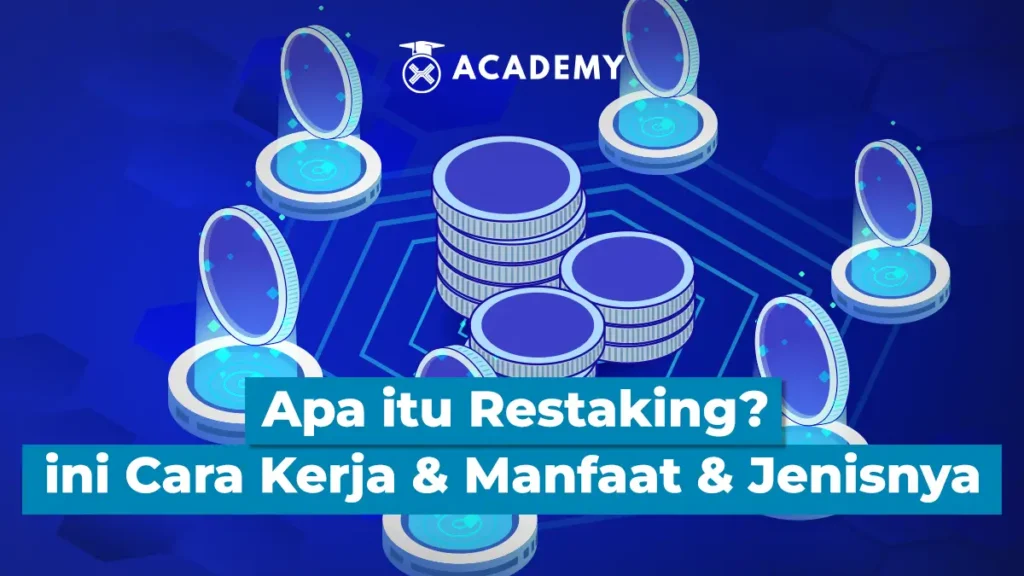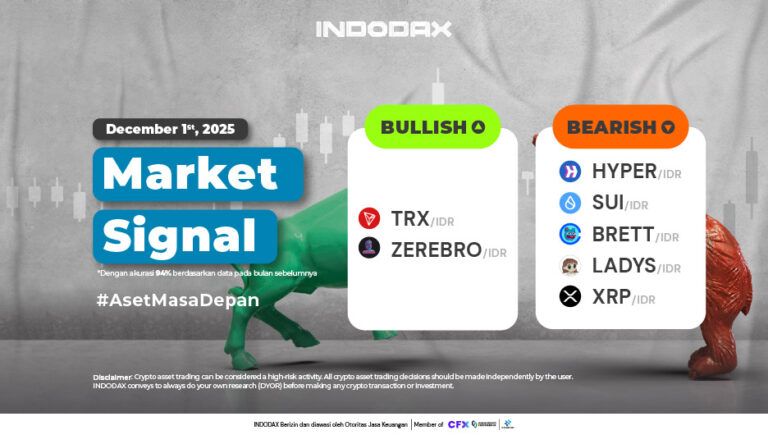At the beginning of 2024, the crypto world was buzzing again. In line with the increase in the value of crypto assets, market participants are actively looking for attractive investment opportunities in the Decentralized Finance (DeFi) sector.
Among the latest DeFi protocols and innovations, EigenLayer is taking the spotlight by introducing an innovative Ethereum restaking concept.
Now, to understand more about what restaking is, from understanding, how it works, benefits, types, to risks, check out the following review.

What is Restaking?
Essentially, restaking through EigenLayer gives Ethereum stakers the opportunity to earn extra income by helping to secure multiple protocols at once.
Users can participate by restaking Ether directly or by depositing Liquid Staking Tokens (LST) such as stETH from Lido.
This utilization of staked ETH allows users to participate in multiple ecosystems with the same asset, increasing capital efficiency for stakers.
New crypto projects can utilize EigenLayer to strengthen their security without having to allocate large resources to build their own pool of validators.
How Restaking Works
For users, there are 2 types of restaking options available, with a full explanation as follows.
1. Native Restaking
This option involves the use of smart contracts to manage assets under the control of validator nodes thus increasing the security of assets from a crypto-economic perspective.
Validators following the native restaking program will need to adopt additional node software specific to the restaking module, allowing them to securely offer their staking assets for reuse in the restaking ecosystem.
2. Liquid Staking
The second option involves the use of Liquid Staking Tokens (LST). In liquid restaking, users stake their assets in certain applications and receive LP (liquidity provider) tokens in return.
The LP tokens can then be used for restaking in other staking protocols.
Key Benefits of Restaking
The following are some of the main benefits of restaking that are important for users to know, including:
1. Flexibility for Stakers to Gain Liquidity and Profits
Restaking provides more flexibility for stakers by allowing them to use staking assets in various financial activities without having to unstake.
It will provide access to liquidity while retaining the profit potential of staking.
2. Addresses the Shortcomings of Traditional Staking that Lock Assets
Restaking reduces the opportunity cost that often arises in traditional staking, where assets are locked and inaccessible.
With restaking, token holders can capitalize on the liquidity of their assets without losing potential profits, making staking more attractive to those who want liquidity and flexibility.
3. Improved Network Security and new DeFi Protocols
New emerging networks or protocols often require additional support in building strong security systems.
Restaking allows these protocols to utilize existing validators from the start, effectively strengthening their security in the early development stages.
4. Optimizing Capital Usage with One Stake in Many Protocols
Restaking allows protocols to customize security levels based on network needs. With this mechanism, protocols can improve security when needed by involving validators from the restaking ecosystem.
Types of Restaking in EigenLayer
Experienced users can explore the different types of restaking, both native staking and liquid staking, and the options available as follows:
1. Restaking Native ETH (Native Staking)
In this option, the validator uses EigenLayer to restake ETH from the Beacon Chain, which has been staked in blocks of 32 ETH.
2. Restaking Liquid Staking Tokens (LST)
These are receipt tokens earned through liquid staking solutions such as Lido, Rocketpool, and others. EigenLayer also supports the use of these tokens.
3. Restaking DeFi Tokens (Wrapped ETH)
Some validators choose to stake wrapped ETH from the DeFi platform, which provides additional rewards from this staking activity.
4. Restaking ETH LP
Under the Restaking ETH LP (Liquidity Provider) option, validators can stake ETH through platforms such as Lido, restaking stETH or LSD tokens (LST) on DEX, then restaking the staked ETH tokens specifically for DEX.
5. Automatic Restaking
Platforms like Ether.fi allow users to stake ETH and receive eETH as liquid staking tokens.
The eETH is automatically integrated with EigenLayer so that the restaking process is done without the need to manually access the EigenLayer interface.

Risks Associated with Restaking
It’s important to understand that not everyone in the crypto ecosystem has welcomed the concept of restaking.
Some have also raised concerns about potential problems that may arise from restaking.
Here are some of the risks associated with restaking that are important for users to be aware of, namely:
1. Potential Centralization of Staking
One of the main concerns is the potential for restaking to trigger staking centralization.
Validators that utilize restaking services may offer higher APYs, which may attract more stakers to those validators, thus reinforcing the dominance of a few large validators.
2. Slashing Risk
Another risk is related to slashing, which is a penalty in the proof of stake blockchain for validators who commit violations.
Ineligible or dishonest validators can have their staking assets reduced, and in a restaking scenario, that risk can increase if validators are involved in multiple protocols at once.
Beyond that, it is important for users to understand the risks above in order to make a more informed decision before engaging in restaking activities.
Conclusion
So, that’s a complete discussion of what restaking is, its benefits, types and risks that we have presented in the crypto academy article.
And in conclusion, restaking has significant long-term potential to change the staking dynamics in the crypto ecosystem.
By allowing users to utilize their staking assets more efficiently through restaking, the concept extends the functionality of traditional staking.
It not only increases liquidity, but also reduces opportunity costs that were previously a constraint for stakers.
In addition, through EigenLayer, stakers can optimize their assets by earning additional revenue without the need to unstake.
New protocols also benefit greatly as they can access existing validators to secure their networks thus saving resources and accelerating the development of security infrastructure.
As for the future, restaking through platforms like EigenLayer has the potential to become an important element in the broader staking ecosystem.
It will provide more flexibility and efficiency for stakers and strengthen the security of various protocols.
However, wider adoption will largely depend on how risks such as centralization and truncation are managed.
If these challenges are overcome, restaking could be a defining innovation in the future of staking and DeFi.
Let’s Staking Crypto at INDODAX Earn
As additional information, for those of you who want to increase your current crypto assets, you can try the crypto staking feature at INDODAX Earn.
Please note, INDODAX Earn is a feature that allows users to lock their crypto assets and earn rewards like interest on bank deposits.
This is done through a mechanism on the blockchain that uses Proof of Stake (PoS) consensus known as staking.
This feature is available through the desktop platform on the INDODAX website and can also be accessed through the INDODAX Mobile application.
So, what are you waiting for? Come on, start staking crypto now with INDODAX Earn!
FAQ
1. What is Ethereum restaking?
Restaking is a mechanism that allows Ethereum stakers to secure multiple protocols at once, increasing capital efficiency by using assets that are already staked.
2. How does restaking work?
Restaking works through two options: native restaking, which involves staking ETH directly, and liquid restaking, which uses Liquid Staking Tokens (LSTs) such as stETH.
3. What are the main benefits of restaking?
Restaking offers stakers the flexibility to gain liquidity without having to unstake, increases network security, and provides additional benefits from a single staking asset.
4. What are the risks associated with restaking?
The main risks of restaking include the potential for centralization of staking and the risk of slashing if validators are dishonest or there is a technical error.
5. What types of restaking are available on EigenLayer?
Types of restaking include native restaking, restaking with LST, DeFi token restaking, ETH LP restaking, and automated restaking through platforms like Ether.fi.





 Polkadot 8.90%
Polkadot 8.90%
 BNB 0.51%
BNB 0.51%
 Solana 4.86%
Solana 4.86%
 Ethereum 2.37%
Ethereum 2.37%
 Cardano 1.18%
Cardano 1.18%
 Polygon Ecosystem Token 2.14%
Polygon Ecosystem Token 2.14%
 Tron 2.85%
Tron 2.85%
 Market
Market


